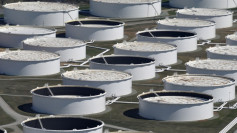Some of the world's largest banks expect oil prices to average $70 per barrel in 2019, with a number projecting prices to reach as high as $78 per barrel.
The expected rebound in oil prices to $70 will be about a third higher than the price on Dec. 27, said a Bloomberg survey of oil analysts. Oil futures in London and New York plummeted this fourth quarter and are expected to do so in January 2019. Volatility surged in the final week of December as crude prices mimicked the wild volatility in Wall Street and leading equities markets worldwide.
Analysts said supply and demand aren't driving the oil market's upsetting volatility. The motive forces are seemingly well-founded concerns about the deteriorating health of the global economy caused by Trump's unnecessary trade war against the world.
"We could even see something similar to a V-shaped recovery next year, on two very important conditions," said Michael Cohen, head of energy and commodities research at Barclays Plc in New York.
He said one condition is the reduction in OPEC exports leads to a reduction in inventories. The second is that countries don't see further deterioration in their macroeconomic conditions.
Some banks see oil prices zooming even higher. The most bullish forecasts came from Morgan Stanley and Standard Chartered Plc, which project Brent to average $78 a barrel in 2019.
On the other hand, Citigroup Inc. believes the relentless growth of U.S. shale production will keep a cap on prices. It predicts that Brent will average $59.50 in 2019 (or about $6 above its price on Thursday) because of the price dampening effect of increased U.S. shale oil production.
In early December, the Organization of Petroleum Exporting Countries (OPEC), and other non-member producers such as Russia, said they will reduce supply by 1.2 million barrels a day in the first half of 2019.
Analysts said the production cut announced by OPEC+ will likely be enough to balance the market in the first half of 2019 and prevent inventories from building.
In addition to the production cut, Saudi Arabia will target the United States with a huge oil export cut to take revenge on a Trump double cross. On average, Saudi Arabia exported 860,000 barrels a day of crude to the U.S. so far this year.
Saudi exports to the U.S. were even higher in the second half of the year. Crude oil exports from July to December rose to an average of 975,000 barrels per day.
Oil industry sources said the Saudis might ship only 582,000 barrels of crude a day to the U.S., which will be lower than the 30-year low set in 2017. This new quantity will be 40 percent lower compared to the most recent three-month average.
The Saudis have informed U.S.-based oil refiners to expect much lower shipments in January 2019. Total Saudi exports will plunge to 7 million barrels a day in January compared to 8 million barrels a day from November to December.
Earlier this year, OPEC boosted production to offset expected losses of Iranian crude from world markets due to U.S. sanctions on Iran. When the sanctions were imposed in early November, however, the Trump administration granted waivers to six of Iran's biggest customers. A supply glut ensued, aggravating an already bad situation.
The result was that OPEC was duped and double-crossed by Trump, said one oil industry analyst. The Saudis now plan to limit exports to the world's largest oil market in the next few weeks in an effort to slash already huge crude inventories -- and take a measure of revenge on Trump.






